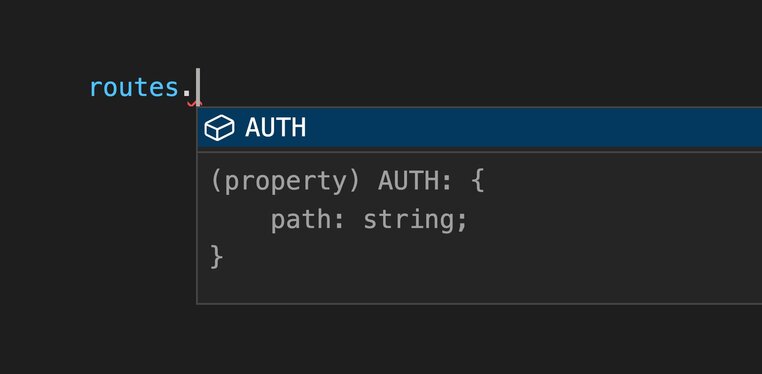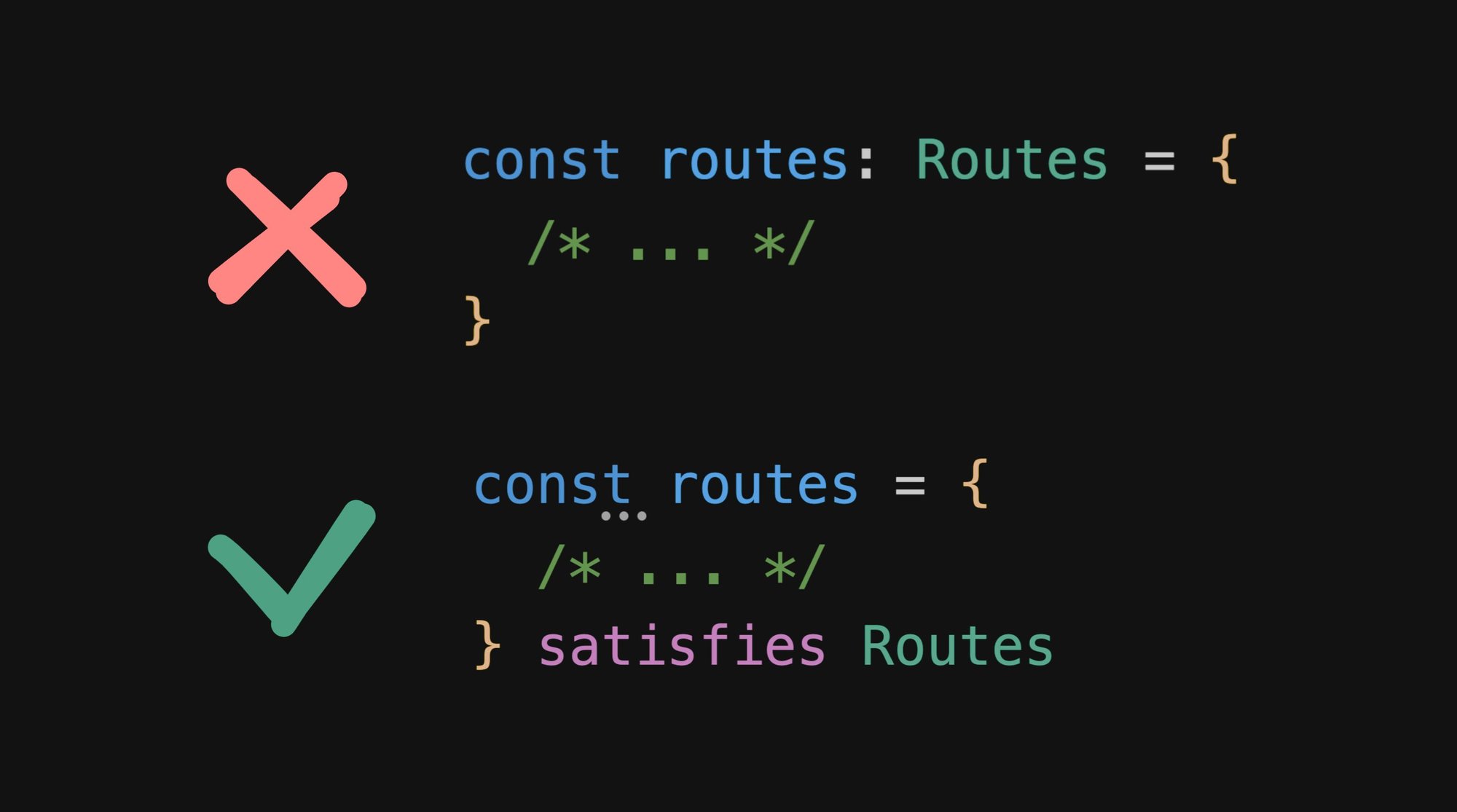There's a new and better way to do type-safe configuration in TypeScript.
It is with the new satisfies operator, released in TypeScript 4.9:
type Route = { path: string; children?: Routes }
type Routes = Record<string, Route>
const routes = {
AUTH: {
path: "/auth",
},
} satisfies Routes; // 😍Let’s start by rewriting the above example with a standard type declaration.
type Route = { path: string; children?: Routes }
type Routes = Record<string, Route>
const routes: Routes = {
AUTH: {
path: "/auth",
},
}Everything looks fine so far. We get proper type checking and completion in our IDE.
But, when we go to use the routes object, the compiler (and subsequently our IDE as well) has no idea what the actual configured routes are.
For instance, this compiles just fine, yet would throw errors at runtime:
// 🚩 TypeScript compiles just fine, yet `routes.NONSENSE` doesn't actually exist
routes.NONSENSE.pathWhy is this? It’s because our Routes type can take any string as a key. So TypeScript approves of any key access, including everything from simple typos to completely nonsense keys. We also get no help in our IDE to autocomplete the valid route keys as well.
You could say “well what about the as keyword”. So why not, we can briefly explore that too:
type Route = { path: string; children?: Routes }
type Routes = Record<string, Route>
const routes = {
AUTH: {
path: "/auth",
},
} as RoutesThis is a common practice in TypeScript, but is actually quite dangerous.
Not only do we have the same issues as above, but you can actually write completely nonexistent key and value pairs and TypeScript will look the other way:
type Route = { path: string; children?: Routes }
type Routes = Record<string, Route>
const routes = {
AUTH: {
path: "/auth",
// 🚩 TypeScript compiles just fine, yet this is not even a valid property!
nonsense: true,
},
} as RoutesBroadly speaking, try to avoid using the as keyword in TypeScript in general.
Now, we can finally rewrite our above examples with the new satisfies keyword:
type Route = { path: string; children?: Routes }
type Routes = Record<string, Route>
const routes = {
AUTH: {
path: "/auth",
},
} satisfies RoutesWith this, we get all of the proper type checking we desire:
routes.AUTH.path // ✅
routes.AUTH.children // ❌ routes.auth has no property `children`
routes.NONSENSE.path // ❌ routes.NONSENSE doesn't existAnd, of course, autocomplete in our IDE:

We can even take a slightly more complex example, like this:
type Route = { path: string; children?: Routes }
type Routes = Record<string, Route>
const routes = {
AUTH: {
path: "/auth",
children: {
LOGIN: {
path: '/login'
}
}
},
HOME: {
path: '/'
}
} satisfies RoutesAnd now we get IDE autocomplete and type checking all the way down the tree, precisely to how we have configured things, as opposed to based on the more general type we used:
routes.AUTH.path // ✅
routes.AUTH.children.LOGIN.path // ✅
routes.HOME.children.LOGIN.path // ❌ routes.HOME has no property `children`Exactly what we wanted.
One last situation you may run into is that with just a plain usage of satisfies , our configuration object is captured a little more loosely than might be ideal.
For instance, with this code:
const routes = {
HOME: { path: '/' }
} satisfies RoutesIf we check the type of the path property, we get the type string
routes.HOME.path // Type: stringBut when it comes to configuration, this is where const assertions (aka as const) have really shined. If we instead used as const here, we would get more precise types, down to the exact string literal '/':
const routes = {
HOME: { path: '/' }
} as const
routes.HOME.path // Type: '/'This may seem like “ok, that’s a neat trick but why do I care”, but let’s consider if we had a method like this that was type-safe all the way down to the exact paths it accepts:
function navigate(path: '/' | '/auth') { ... }If we just used satisfies, where each path is only known to be a string, we would get type errors here:
const routes = {
HOME: { path: '/' }
} satisfies Routes
navigate(routes.HOME.path)
// ❌ Argument of type 'string' is not assignable to parameter of type '"/" | "/auth"'Argh! HOME.path is a valid string ('/'), but TypeScript is saying it’s not.
Well, that’s where we can get the best of all worlds by combining satisfies and as const like so:
const routes = {
HOME: { path: '/' }
- } satisfies Routes
+ } as const satisfies RoutesNow, we have a great solution, with type checking all the way down to the exact literal values we used. Beautiful.
const routes = {
HOME: { path: '/' }
} as const satisfies Routes
navigate(routes.HOME.path) // ✅ - as desired
navigate('/invalid-path') // ❌ - as desiredSo finally, you might ask, why not just use as const instead of satisfies?
Well, with just as const, we won’t get any type checking of our object itself at the time of authoring it. So that means no autocomplete in our IDE or warnings for typos and other issues at the time of writing.
This is why the combination here is so effective.
The biggest benefit you’ll likely get from this new operator is support in popular libraries and frameworks that you use.
For instance, with NextJS, if you previously wrote:
export const getStaticProps: GetStaticProps = () => {
return {
hello: 'world'
}
}
export default function Page(
props: InferGetStaticPropsType<typeof getStaticProps>
) {
// 🚩 Typo not caught, because `props` is of type `{ [key: string]: any }`
return <div>{props.hllo></div>
}props in this case is just { [key: string]: any }. Sigh, not very helpful.
But with satisfies, you can instead write:
export const getStaticProps = () => {
return {
hello: 'world'
}
} satisfies GetStaticProps
export default function Page(
props: InferGetStaticPropsType<typeof getStaticProps>
) {
// 😍 `props` is of type `{ hello: string }`, so our IDE makes sure our
// code is correct
return <div>{props.hello}</div>
}And with this you get all of the same type checking and completion that you did before, but now the proper props type { hello: string }
Typescript 4.9 introduced the new satisfies keyword, which is extremely handy for most configuration-related tasks in TypeScript.
Compared to a standard type declaration, it can strike an elegant balance between type checking and understanding the exact details of your configuration for optimal type safety and a great in-IDE.
Thank you to u/sauland for proposing this routes example, as well as to Matt Pocock and Lee Robinson for the NextJS example.
Hi! I'm Steve, CEO of Builder.io.
We make a way to drag + drop with your components to create pages and other CMS content on your site or app, visually.
You can read more about how this can improve your workflow here.
You may find it interesting or useful:
Additional Web Development Resources
Builder.io visually edits code, uses your design system, and sends pull requests.
Builder.io visually edits code, uses your design system, and sends pull requests.




 Connect a Repo
Connect a Repo











